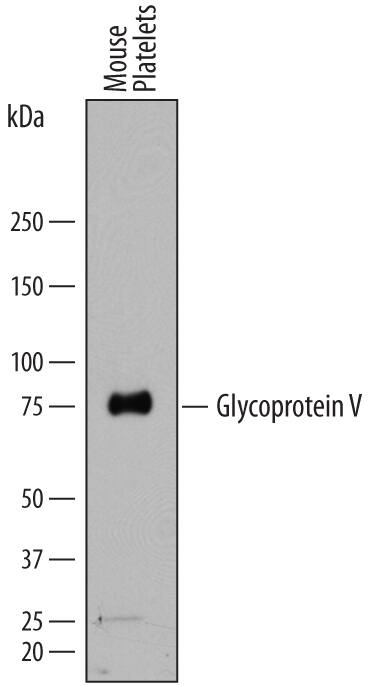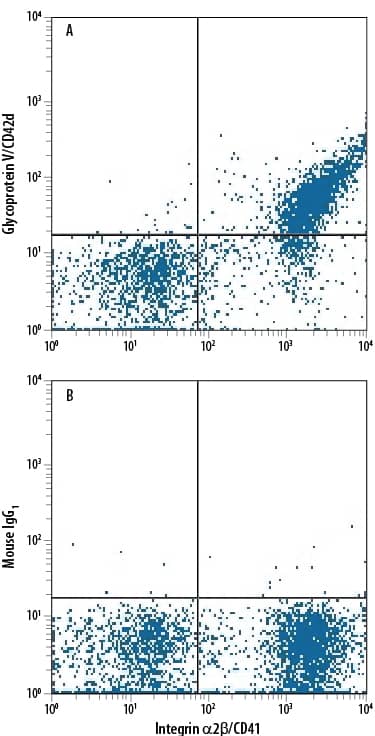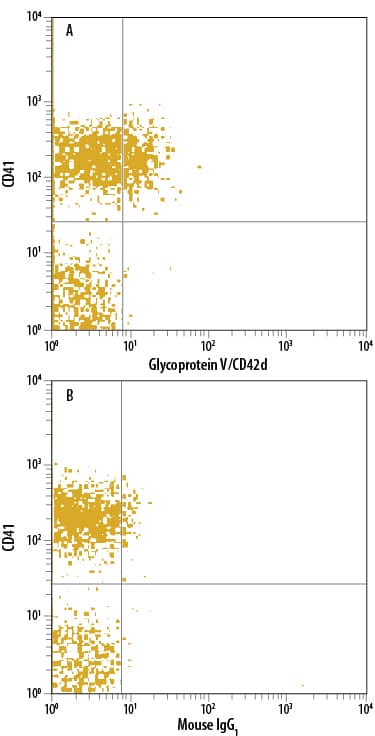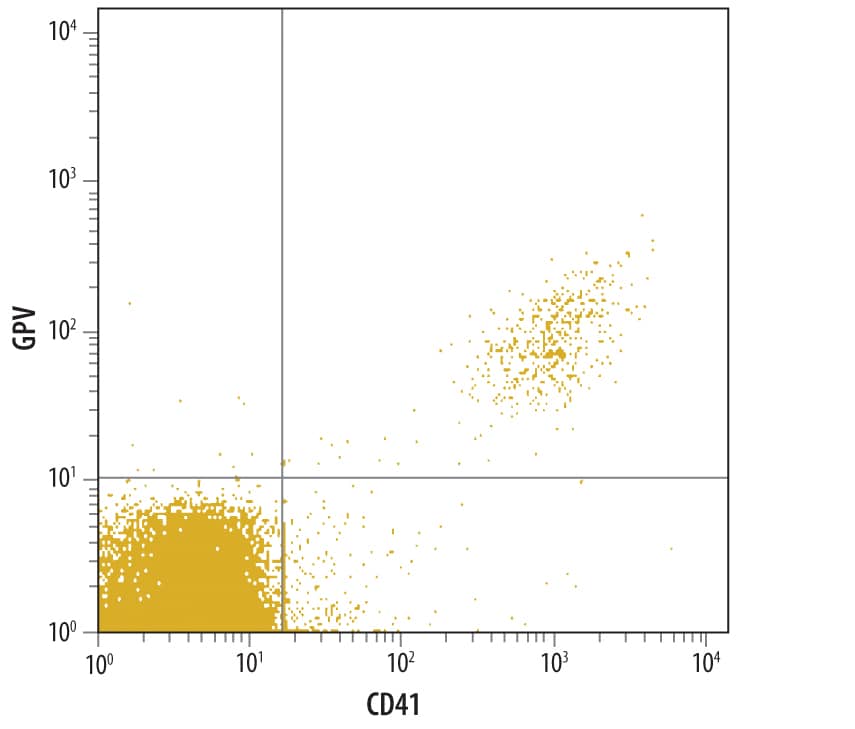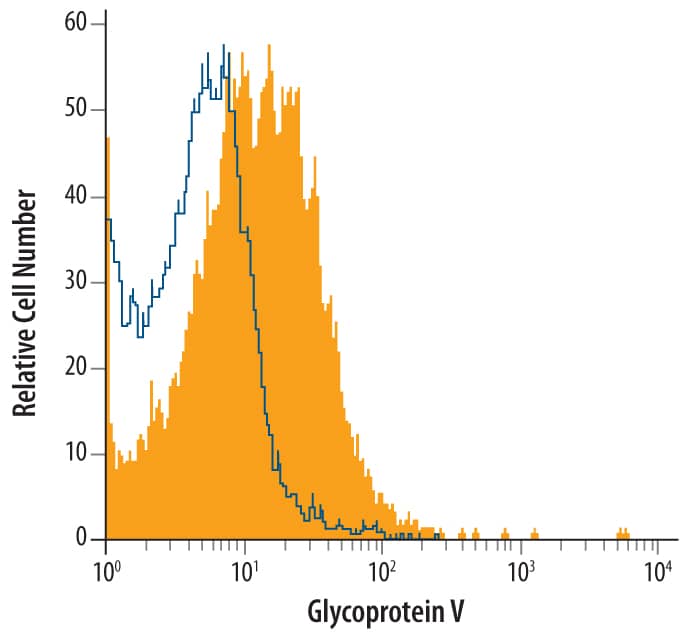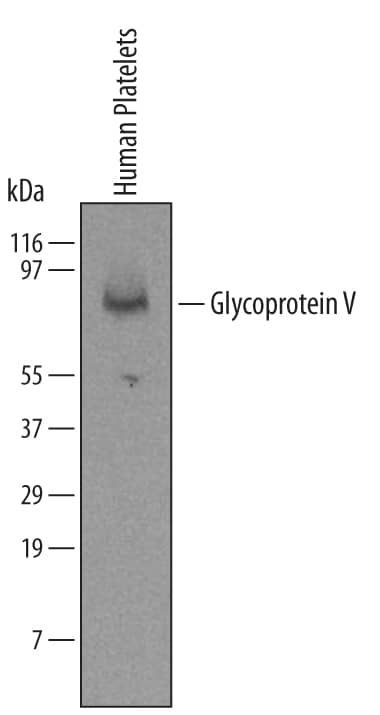Glycoprotein V/CD42d Products
GPV (platelet glycoprotein V; designated CD42d) is an 83 kDa type I transmembrane (TM) glycoprotein of the leucine-rich repeat (LRR) family. It is expressed exclusively within the platelet / megakaryocyte lineage, where it noncovalently interacts with other platelet TM LRR proteins, GPIb alpha/beta and GPIX, at a ratio of one GPV to two of each other subunit. The GPI-V-IX complex tethers platelets to von Willebrand factor on the surface of injured endothelial cells. Absence of the complex results in Bernard-Soulier syndrome, a rare bleeding disorder. The human GPV cDNA encodes a 560 amino acid (aa) protein with a 16 aa signal sequence, a 507 aa extracellular domain (ECD) containing 15 LRR, a 21 aa TM sequence, and a short (16 aa) cytoplasmic tail that binds calmodulin in resting, but not activated platelets. The human GPV ECD shares 70%, 71% and 81% aa identity with mouse, rat and equine GPV, respectively. GPV can form soluble fragments of 80 kDa by ADAM10 or ADAM17 cleavage after P507, or 69 kDa by thrombin cleavage after R476. High circulating soluble GPV may be an indicator of platelet activation, but may also be caused by high doses of aspirin. The function of GPV is not entirely clear. Deletion of GPV in mice does not produce any obvious change to surface expression or function of GPIb and GPIX, but surface expression of GPV requires GPIb. Deletion studies also indicate that GPV may play a minor role in collagen adhesion, and may modify platelet aggregation in response to thrombin.
77 results for "Glycoprotein V/CD42d" in Products
77 results for "Glycoprotein V/CD42d" in Products
Glycoprotein V/CD42d Products
GPV (platelet glycoprotein V; designated CD42d) is an 83 kDa type I transmembrane (TM) glycoprotein of the leucine-rich repeat (LRR) family. It is expressed exclusively within the platelet / megakaryocyte lineage, where it noncovalently interacts with other platelet TM LRR proteins, GPIb alpha/beta and GPIX, at a ratio of one GPV to two of each other subunit. The GPI-V-IX complex tethers platelets to von Willebrand factor on the surface of injured endothelial cells. Absence of the complex results in Bernard-Soulier syndrome, a rare bleeding disorder. The human GPV cDNA encodes a 560 amino acid (aa) protein with a 16 aa signal sequence, a 507 aa extracellular domain (ECD) containing 15 LRR, a 21 aa TM sequence, and a short (16 aa) cytoplasmic tail that binds calmodulin in resting, but not activated platelets. The human GPV ECD shares 70%, 71% and 81% aa identity with mouse, rat and equine GPV, respectively. GPV can form soluble fragments of 80 kDa by ADAM10 or ADAM17 cleavage after P507, or 69 kDa by thrombin cleavage after R476. High circulating soluble GPV may be an indicator of platelet activation, but may also be caused by high doses of aspirin. The function of GPV is not entirely clear. Deletion of GPV in mice does not produce any obvious change to surface expression or function of GPIb and GPIX, but surface expression of GPV requires GPIb. Deletion studies also indicate that GPV may play a minor role in collagen adhesion, and may modify platelet aggregation in response to thrombin.
| Reactivity: | Human |
| Details: | Mouse IgG1 Monoclonal Clone #508209 |
| Applications: | Flow |
| Source: | NS0 |
| Accession #: | P40197 |
| Applications: | BA, BA |
| Reactivity: | Human |
| Details: | Mouse IgG1 Monoclonal Clone #508209 |
| Applications: | Flow |
| Reactivity: | Human |
| Details: | Mouse IgG1 Monoclonal Clone #508209 |
| Applications: | Flow |
| Reactivity: | Human |
| Details: | Mouse IgG1 Monoclonal Clone #508209 |
| Applications: | Flow |
| Reactivity: | Human |
| Details: | Mouse IgG1 Monoclonal Clone #508209 |
| Applications: | Flow |
| Reactivity: | Human |
| Details: | Mouse IgG1 Monoclonal Clone #508209 |
| Applications: | Flow |
| Reactivity: | Human |
| Details: | Mouse IgG1 Monoclonal Clone #508209 |
| Applications: | Flow |
| Reactivity: | Mouse, Rat |
| Details: | Armenian Hamster IgG Monoclonal Clone #1C2 |
| Applications: | IHC, Flow, IP |
| Source: | NS0 |
| Accession #: | NP_032174 |
| Applications: | BA |
| Reactivity: | Human |
| Details: | Rabbit IgG Polyclonal |
| Applications: | ICC/IF |
| Applications: | AC |
| Reactivity: | Human |
| Details: | Mouse IgG1 Monoclonal Clone #508209 |
| Applications: | Flow, CyTOF-ready |
| Reactivity: | Mouse, Rat |
| Details: | Armenian Hamster IgG Monoclonal Clone #1C2 |
| Applications: | IHC, Flow, IP |
| Reactivity: | Human |
| Details: | Mouse IgG1 Monoclonal Clone #508209 |
| Applications: | Flow, CyTOF-ready |
| Reactivity: | Mouse, Rat |
| Details: | Armenian Hamster IgG Monoclonal Clone #1C2 |
| Applications: | IHC, Flow, IP |
| Reactivity: | Mouse, Rat |
| Details: | Armenian Hamster IgG Monoclonal Clone #1C2 |
| Applications: | IHC, Flow, IP |
| Reactivity: | Mouse |
| Details: | Sheep IgG Polyclonal |
| Applications: | WB, ICC |
| Reactivity: | Human |
| Details: | Mouse IgG1 Monoclonal Clone #508209 |
| Applications: | Flow |
| Reactivity: | Human |
| Details: | Mouse IgG1 Monoclonal Clone #508209 |
| Applications: | Flow |
| Reactivity: | Human |
| Details: | Sheep IgG Polyclonal |
| Applications: | WB, Flow, CyTOF-ready |
| Reactivity: | Human |
| Details: | Mouse IgG1 Monoclonal Clone #508209 |
| Applications: | Flow, CyTOF-ready |
| Reactivity: | Human |
| Details: | Mouse IgG2b Monoclonal Clone #508219 |
| Applications: | WB |
| Reactivity: | Human |
| Details: | Mouse IgG1 Monoclonal Clone #508209 |
| Applications: | Flow, CyTOF-ready |



![Flow Cytometry: Glycoprotein V/CD42d Antibody (1C2) [NBP2-00071] Flow Cytometry: Glycoprotein V/CD42d Antibody (1C2) [NBP2-00071]](https://resources.bio-techne.com/images/products/GPV-Antibody-1C2-Flow-Cytometry-NBP2-00071-img0001.jpg)

![Immunocytochemistry/ Immunofluorescence: Glycoprotein V/CD42d Antibody [NBP3-17857] Immunocytochemistry/ Immunofluorescence: Glycoprotein V/CD42d Antibody [NBP3-17857]](https://resources.bio-techne.com/images/products/Glycoprotein-V-CD42d-Antibody-Immunocytochemistry-Immunofluorescence-NBP3-17857-img0001.jpg)

